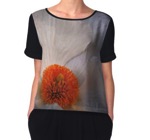Starting a series within a series, I will be highlighting shade plants that grow well underneath trees, especially California Live Oak. I have a deep shade area beneath many trees here in my own garden and i am constantly looking for plants that can help green this area. — Douglas
A good ground cover that could cope with my trees would be much appreciated, so I am going to look into Wild Ginger more deeply. There are large areas that could benefit from its spearing habit and the lack of maintenance required for the plant would be nice, too.
Wild Ginger (Asarum caudatum)
By Walter Siegmund – Own work, CC BY 2.5, https://commons.wikimedia.org/w/index.php?curid=2176503
What are your thoughts on this Interesting Plant? Drop a note in the comments!
Asarum caudatum (British Columbia wild ginger, western wild ginger, or long-tailed wild ginger) is native to rich moist forests of western North America from British Columbia to California and as far east as western Montana. It an evergreen with flowers that develop from March to August.[citation needed] The flowers are distinct, hirsute(hairy), cup-shaped, and brown-purple to green-yellow which terminate in three, long, gracefully curved lobes, often concealed by leaves. The long rhizomes give rise to persistent reniform (kidney/heart shaped) leaves. Leaves are found in colonies or clusters as the rhizome spreads, forming mats.[3] The leaves emit a ginger aroma when rubbed.[4]
Caudatum comes from the Latin cauda meaning tail. This refers to the tail-like shape of the flower’s calyx.
Asarum caudatum is found in British Columbia, Washington, Oregon, Northern California,[5] Idaho, and Montana[3] in moist, shaded environments. It is a typical herb found in the understory of mixed conifer forests under 2,200 feet in elevation, and is often a dominant plant.[6][7] It reproduces rhizomatously, meaning many mats are formed by oneclonal plant connected by a rhizome. A. caudatum can also reproduce sexually, with its seeds dispersed by ants. Their flowers are pollinated by flies. However, cross-pollination is rare. Ants are attracted by a fatty appendage attached to the seed.[8]
The ants carry the entire package back to their colonies. The seed is often dropped outside the nest once the ant realizes only the appendage is edible. Due to the costs of producing seeds with an appendage to attract ants, it is more energetically favorable for the plant to reproduce rhizomatously. — Wikipedia
More information on Asarum caudatum:
- Wild Ginger (Asarum caudate) on Wikipedia
- Wild Ginger (Asarum caudate) at Las Pilitas Nursery
- Wild Ginger (Asarum caudate) at US Forest Service



- Begonia Rex (Painted-leaf begonia)
- Leonotis leonurus
- Matilija Poppy (Romneya)
- Melocactus matanzanus (Turk’s Cap Cactus)
- Coleus “Redhead”
- Tiarella ‘Pink Skyrocket’
- Bacopa monnieri (Water hyssop)
- Lycoris squamigera (Naked Lady Lily)
- Kong Coleus (Plectranthus/Solenostemon scutellarioides “Kong Series”)
- Crassula plegmatoides
- Agave victoriae-reginae
- Mountain Cornflower (Centaurea montana)
- Euphorbia ‘Black Bird’
- Firecracker vine (Ipomoea lobata)
- Eryngium yuccifolium
- Dahlia ‘Karma Choc’
- Echeveria Agavoides
- Jerusalem Sage (Phlomis fruticosa)
- Hummingbird Sage (Salvia spathacea)
- Seaside Daisy, Beach Aster (Erigeron glaucus)
- Toyon (Heteromeles arbutifolia)
- California Lilac (Ceanothus)
- Bigberry Manzanita (Arctostaphylos glauca)
- Douglas Iris (Iris douglasiana)
- Malva Rosa (Lavatera assurgentiflora)
- Baby Blue-Eyes (Nemophila)
- Coral Bells or Alum Root (Heuchera)
- Deer Grass (Muhlenbergia rigens)
- Echeveria ‘Lola’
- View all past “Interesting Plant” posts
Interesting Plant is a series from A Gardener’s Notebook blog and podcast that highlights the most interesting plants I find in my Internet and real-world travels — Douglas




